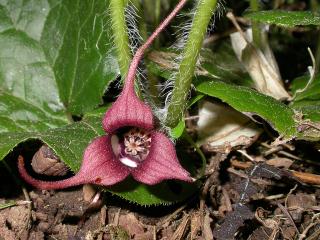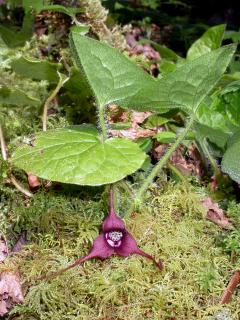Wild Ginger (Asarum caudatum)

By Andrea Ruchty
Asarum caudatum, wild ginger [British Columbia wild ginger], is a native perennial forb that is evergreen throughout most of its range. It grows as an understory plant in moist, montane forests (0-1200 meters / 2200 feet) of the Pacific Northwest, and is found in British Columbia, Washington, Oregon, California, Idaho, and western Montana, where it grows in zones with mild, wet winters (lows 15-25 degrees F) and warm, dry summers.
Wild ginger is a member of the birthwort family (Aristolochiaceae). Deep green, hirsute, heart shaped leaves with distinctive, prominent venation, and unique purplish-brown colored flowers, with three long, radiating calyx segments, distinguish the species. Flowers are produced beneath leaves in spring-summer (April - July), and are often hidden from view. The first indication that you may have that wild ginger is near is the pungent, sweet ginger fragrance released as make your way through the forest, unknowingly treading on the leaves of this plant.
Wild ginger has slender, elongate, shallow rhizomes, and often reproduces rhizomatously, although it also reproduces sexually through the production of seeds. Seeds include a fleshy appendage rich with oils that attract ants, which act as an important dispersers of this plant. In parts of its range, wild ginger may comprise an important food source for rodents (particularly pocket gophers). The species is also palatable to slugs. Wild ginger is thought to have antibiotic properties, and Native Americans used this plant to treat headaches, intestinal pain, knee pain, arthritis, indigestion, tuberculosis, colic and as a general tonic.
For More Information


